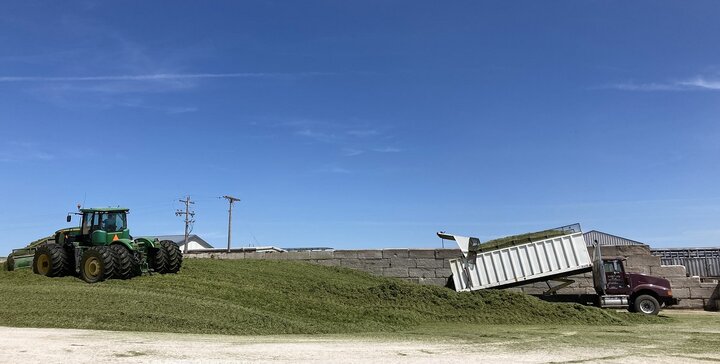Small grains are an excellent choice as a double-cropped forage for a spring silage crop. However, making good quality small grain silage takes careful moisture management.
Recently, 17 Nebraska producers provided small grain forage samples at harvest and again after fermentation to evaluate changes in nutrient content and the quality. At harvest, 50% of the samples were within the suggested range of target dry matter for small grain silage (30 to 35% DM), 40% were too wet ( 40% DM). The majority (85%) of the producers stated that they had wilted the crop before packing. However, many did not wilt long enough for the forage to dry enough to achieve adequate dry matter content. The likely cause was that the forage on top of the swath began to dry out, while the forage underneath remained wet. The time needed for wilting will depend on the stage of plant maturity and weather conditions. Generally, as the plants mature, they will get drier. Weather conditions such as wind speed, temperature, and the relative humidity can affect the rate of field drying. The combination of these weather variables makes it difficult to determine how long to wilt before chopping and packing. Based on survey data, producers that wilted small grains harvested at boot, heading, or pollination stage for 16 to 24 hours appeared to be more likely to achieve targeted DM content. For later maturities in the milk or soft dough stage, less wilting (0 to 2 hours) seemed to result in desirable results.
So why all the fuss about getting the moisture content right?
Energy (TDN) loss of silage samples ranged from 0 to 17 TDN units from packing to feed out. Samples with greatest TDN loss were too wet at packing. Silage packed too wet had almost 3 times more energy loss than samples packed within the target DM (Table 1). Silage that is packed too wet can have the wrong type of fermentation, in which clostridial bacteria use the nutrients in the forage to grow and produce butyric acid. This reduces the palatability and feed value of the silage. In fact, silage that undergoes clostridial fermentation never becomes preserved and will continue to lose energy content in storage. Thus, it is better to feed the silage as quickly as possible rather than storing it for later use if it was too wet at packing.
| Too wet | Within target | |
|---|---|---|
| # of samples | 8 | 10 |
| Avg. DM at packing, % | 25% | 34% |
| TDN, % of DM | ||
| At packing | 57% | 57% |
| At feedout | 49% | 54% |
| TDN unit loss | 8 | 3 |
Can inoculants help?
Fermentation leading to the rapid production of lactic acid results in the least amount of energy lost during fermentation. Of the silage that was packed too wet, TDN loss was 11.2 units for non-inoculated silage vs. 5.9 units for silage that was inoculated. While inoculation appeared to reduce the energy loss, there was still a 10% energy loss of the forage. For silage within the target DM range, there did not appear to be an impact of inoculation on energy loss, likely because loss was already quite low. Reaching the target DM range prior to packing is always best. However, silage inoculants can be useful insurance. There are many different silage inoculants on the market. For small grain silages, the biggest challenge is achieving a rapid drop in pH to preserve the forage. Therefore, using a homolactic acid-based inoculant is recommended.
For more information on making small grain silage, check out the proceedings and videos from the 2022 silage conference. Topics covered include agronomic management of small grain for silages, when to harvest small grain silage, why fermentation analysis is important and what it means for your operation, fundamentals of silage harvest management, and inoculants for small grain silage.
Resources
Video & Proceedings of 2022 Small Grain Silage Conference
Interviews with the authors of BeefWatch newsletter articles become available throughout the month of publication and are accessible at https://go.unl.edu/podcast. You can subscribe to the BeefWatch newsletter here: http://go.unl.edu/Beefwatch_subscribe.

